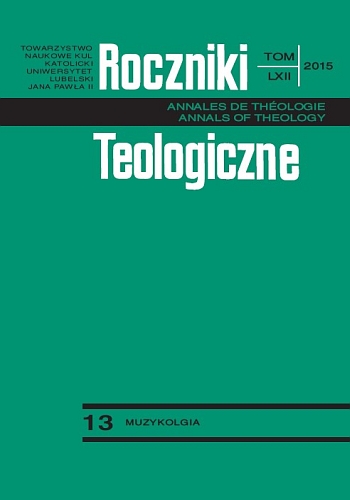Instrumental Music Repertoire of the Piarist Ensemble from Podolínec
Instrumental Music Repertoire of the Piarist Ensemble from Podolínec
Author(s): Dariusz SmolarekSubject(s): Music
Published by: Towarzystwo Naukowe KUL & Katolicki Uniwersytet Lubelski Jana Pawła II
Keywords: instrumental music in seventeenth and eighteenth centuries;composers in seventeenth and eighteenth centuries;musical culture of churches and monasteries;church music;Piarists;Podolínec;
Summary/Abstract: European church archives contain, in addition to polyphonic vocal and instrumental music, also instrumental compositions bearing the names of: sinfonia, sinphonia, synfonia, synphonia, symfonia, symphonia, simphonia, sonata, duetto, trio, terzetto, trietto, quadro, quartet, octetto, divertissement, divertimento, serenada, cassatio, overture, concerto. This phenomenon applies also to church centres in Poland (e.g. Pauline monastery at Jasna Gora in Czestochowa, Dominican monastery in Gidle, Cistercian abbey in Cracow-Mogila), the archival collection of which includes a large amount of this type of music from the seventeenth and especially from the eighteenth century. The order of Scholarum Piarum, that is Piarists, active in Italy, Austria, Czech Republic, Slovakia and Poland, was also a part of this phenomenon. In the colleges of this order, located within the boundaries of the then Polish-Lithuanian Commonwealth e.g. in Lowicz, Rzeszow, Piotrkow, Zloczow, Wielun and Podolínec, there also sounded instrumental music. The repertoire of instrumental music originating from the former monastery and Piarist College in Podolínec, recorded in the inventories and preserved in the form of manuscripts and printing includes as follows: church sonatas, baroque violin concertos, pre-classical and classical trios, pre-classical symphonies, overtures to operas, keyboard instrument music. Instrumental pieces were used for the purposes of teaching, during recreation, in school theater performances and during the liturgy. In Podolínec, Proper Missæ chants were probably replaced with instrumental music, as it was commonly practised in Europe in the eighteenth century.
Journal: Roczniki Teologiczne
- Issue Year: 62/2015
- Issue No: 13
- Page Range: 137-175
- Page Count: 39
- Language: English

